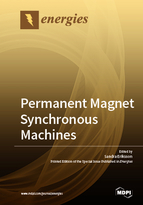Permanent Magnet Synchronous Machines
A special issue of Energies (ISSN 1996-1073). This special issue belongs to the section "I: Energy Fundamentals and Conversion".
Deadline for manuscript submissions: closed (28 February 2019) | Viewed by 72315
Special Issue Editor
Interests: permanent magnet synchronous machines, generator design, FEM simulations, alternative permanent magnet materials, electrical systems, control strategies, wind turbines, wave power, electric propulsion systems
Special Issue Information
Dear Colleagues,
The interest in permanent magnet synchronous machines (PMSMs) is continuously increasing in the world. With the growing global energy demand and awareness of climate aspects, electrification is increasing in several areas. Permanent magnet synchronous generators are in demand for wind power, as well as for novel renewable energy technologies such as wave power and tidal power. Another emerging market for permanent magnet machines is as electric motors, mainly for cars but also for heavier road transport, as well as electrification of ships and aircraft.
This Special Issue will focus on PMSMs and the electrical systems they are connected to. Papers are invited in all different areas of PMSMs, as machines are a multidisciplinary topic involving research areas such as electromagnetism, mechanical design, thermal management, and material issues, as well as economical and environmental aspects. Both theoretical and experimental work, and, especially, the combination of these, are welcomed. Recently, an interest in reducing the use of rare earth metals has been raised, and therefore papers exploring substitution and reduction of rare earth metals in PM machines are encouraged.
Topics of interest for publication include, but are not limited to, the following:
- Permanent magnet synchronous machine design
- Modelling of PM machines
- Innovative designs of PM machines
- Drive systems for PM motors
- Electrical systems and control strategies for PM generators
- Substitution or reduction of rare earth metals in PM machines
- Demagnetization risk for PMs in synchronous machines
- Thermal design and losses
- Mechanical design
- PM pilot exciters
- PM assisted synchronous reluctance machines
Prof. Dr. Sandra Eriksson
Guest Editor
Manuscript Submission Information
Manuscripts should be submitted online at www.mdpi.com by registering and logging in to this website. Once you are registered, click here to go to the submission form. Manuscripts can be submitted until the deadline. All submissions that pass pre-check are peer-reviewed. Accepted papers will be published continuously in the journal (as soon as accepted) and will be listed together on the special issue website. Research articles, review articles as well as short communications are invited. For planned papers, a title and short abstract (about 100 words) can be sent to the Editorial Office for announcement on this website.
Submitted manuscripts should not have been published previously, nor be under consideration for publication elsewhere (except conference proceedings papers). All manuscripts are thoroughly refereed through a single-blind peer-review process. A guide for authors and other relevant information for submission of manuscripts is available on the Instructions for Authors page. Energies is an international peer-reviewed open access semimonthly journal published by MDPI.
Please visit the Instructions for Authors page before submitting a manuscript. The Article Processing Charge (APC) for publication in this open access journal is 2600 CHF (Swiss Francs). Submitted papers should be well formatted and use good English. Authors may use MDPI's English editing service prior to publication or during author revisions.
Keywords
- permanent magnet synchronous generator
- permanent magnet synchronous motor
- electric propulsion systems
- renewable energy
- energy conversion






